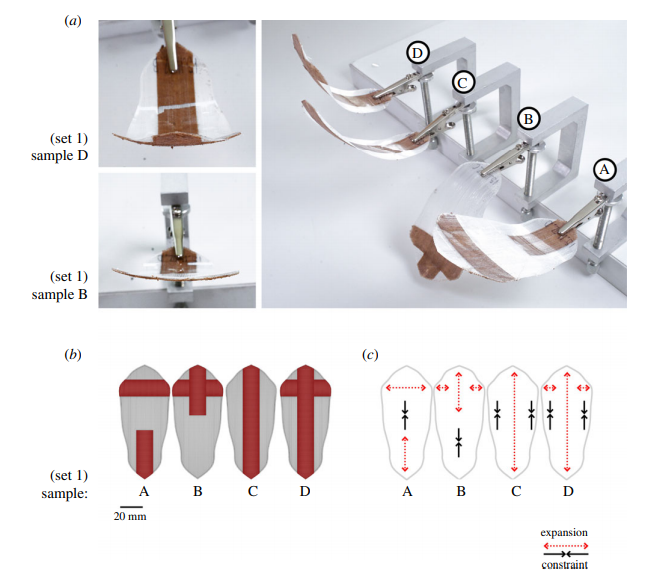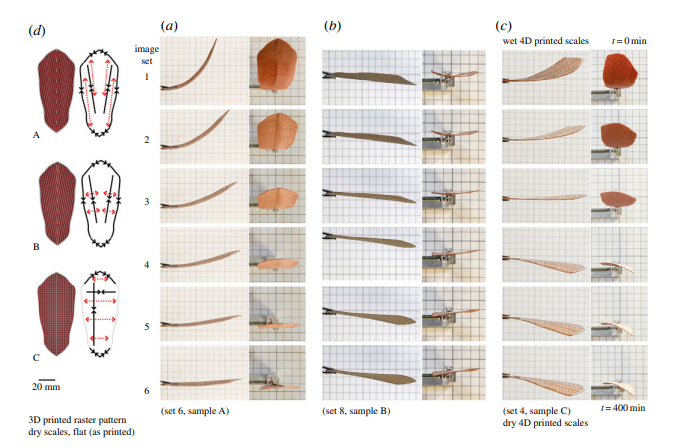Biomimetic 4D printed Autonomous Scale & Flap Structures: Pine Cones as Inspiration
Researchers from Canada and Germany walk that fine line from the 3D into the 4D, sharing their findings in ‘4D pine scale: biomimetic 4D printed autonomous scale and flap structures capable of multi-phase movement,’ recently published in Philosophical Transactions of the Royal Society A.
Because much of the 4D movement is centered around objects that can deform and then revert back to their initial shape, scientists involved in such research are usually focused on the study of a wide variety of materials, from reinforced composites to biopolymers, metamaterials, and more. Here, the authors are concerned with a complex ‘biomimetic hygro-responsive composite.’
It is not uncommon to find that scientists are inspired by nature and in fascinating ways. Not to disappoint here, either, the scientists were motivated to create biomimetic materials due to the reversibility in the shape of Bhutan pine (Pinus wallichiana) cone seed scales. In studying the complexity of the pine cone seed scales, the researchers hoped to create ‘versatile and self-sufficient scale and flap systems.’
In relation to 4D deformability, the researchers studied how pinecones are affected by moisture in their environment, remaining closed while they are wet, keeping their seeds protected, and then opening when it is dry, allowing the seeds to be released on the wind.

(Overleaf.) Pinecone seed scale functional morphology and kinematics. The scales passively react to changing environmental humidity conditions leading to a closed cone when it is wet (a) and to an open cone when it is dry (b). A longitudinally halved cone in the dry condition (c). The actuating sclereid layer is not tightly connected to the sclerenchymatous strands, which are embedded in a matrix of ‘brown tissue’ (sensu [15]) (d,e) and reach towards the apical apophysis (f). Images (d–f) modified from [16]. Light microscopy image of a semi-thin cross-section of the functional bilayer set-up (g), one sclerenchymatous strand (h), a detail of the sclereid layer (i), a detail of the sclerenchymatous strand (j), and a detail of the ‘brown tissue’ (k). Fluorescence microscopy of an acridine orange-stained semi-thin longitudinal section of a scale (l). The brightness indicates the degree of lignification, which is of increasing intensity in the sclereid layer towards the sclerenchymatous layer, high in the sclerenchymatous strand itself, and low in the ‘brown tissue’ (abbreviated as ‘B.’). (m) The bi-axial, two-phase, passive-nastic movement of the Bhutan pine (Pinus wallichiana) seed cone scale. An initially wet seed scale (in frontal and lateral view, clamped with its basal part by a forceps) undergoes two successive bending deformation processes upon desiccation (at approx. 20°C, approx. 50% RH). At the beginning (t = 0) the scale is wet, straight (without any conspicuous longitudinal curvature) and possesses a notable transversal curvature by which longitudinal bending is hindered. After t = 15 min, the transversal curvature alone has markedly decreased. Afterward, the scale starts to bend longitudinally until a maximum bending angle (which depends on the extent of scale desiccation, i.e. on the environmental conditions) is achieved after t = 60 min. (Online version in color.)
“Such passive waterdriven motion responses are nastic and, therefore, structurally ‘programmed’ into the individual seed scales,” explained the researchers. “Each scale forms a functional bilayer structure through a gradation in its tissue structure, from the sclereid cells at the bottom of the scale to a region of sclerenchymatous strands at the top.”
The sclereid layer serves as the actuating layer, while the sclerenchymatous layer serves as the resistant layer. Together, the layers either bend upward due to moisture levels or bend downward after drying—with the cone opening.
“Furthermore, the structural integrity of the cone scales can be conserved for millions of years, highlighting extraordinary functional resilience and robustness,” said the researchers. “The stratification of the pinecone scale’s functional bilayer set-up is not homogeneous and the dimensions of sclereid and sclerenchymatous tissues vary over the length of the individual scale.”
For this study, the researchers used an FFF 3D printer with ‘high-performance lightweight composites,’ along with reinforced polymers, and wood composites too, mixed with a co-polyester polymer matrix and able to imitate the swellable lower sclereid layer. They also used ABS as it is still vulnerable to moisture but it ‘undergoes negligible dimensional changes compared to WPC.’ For that reason, the researchers used ABS material to imitate the stiffer upper layer as they created a functional sample.

The 4D functional model of the bi-axial curvature deformation. An initial set of 3D printed scales using differentiated bilayer regions composed of a constraint layer of oriented TPU and an oriented hygroscopic layer of WPC. (a) Fully wet 4D printed samples show different double curvature deformations in response to localized bilayer structure. (b) Localized WPC raster pattern regions in relation to the global shape of the scale. (c) The direction of hygroscopically induced expansion on WPC layer shown in relation to the dominant axis of oriented TPU constraint. (Online version in color.)

3D printing multi-material process to create the 4D printed artificial pinescales. Several different raster patterns were produced using ABS and WPC to test and evaluate suitable bilayer architectures. (a) After printing, all samples are laminar and have no curvature in either longitudinal or axial directions. (b) Photo of 3D printing process exposing ‘weave’ architecture at multiple states of print completion. (Online version in color.)
The research team created 54 movement sequences of the pinecone scale, imitating a natural environment by submitting the material alternately to a drying oven and an aquarium. They also noted that after all the experimentation, the scale was still undamaged and with no signs of delamination.

4D printed scales with a ‘weave’ bilayer architecture and with WPC raster pattern at 0° from the scale’s longitudinal axis. Having the same 3D printed raster pattern for all three sets of samples (a), 4D scales show different shape deformations when fully wet (c) in response to changes to the bilayer constraints in both the longitudinal and lateral axis as well as the boundary edge of the scale (b). Samples with single constraints in either longitudinal or lateral directions (sets 2–4, B and C samples) had simple bending deformation perpendicular to the constraint direction, consistent with simple bilayer behavior. Samples with constraints in both axes(sets 2–4, A samples) had atwist bending deformation. Samples with no axial constraints presented very limited shape change (sets 2–4, D samples). (Online version in color.)
The researchers were able to transfer a motion sequence they observed via the pinecone scales into a 4D printed artificial scale, offering potential in the future for other studies delving into robotics and methods for triggering motion like steps.

The 4D printed artificial scales distinct shape bending deformation, of three different bilayer architectures A, B and C (d), upon desiccation. All three scales are clamped at the basal region and present a continuous,single-phase, actuation bending of predominantly single-axis curvature change. Each sample demonstrates a differentiated shape-change deformation based on the bilayer architecture(d). Starting fully wet(t = 0, imageset1),sample A(a) presents notable longitudinal curvature with negligible transversal curvature,sample B(b) presents the opposite condition with notable transversal curvature with negligible
longitudinal curvature, sample C (c) presents curvature change at an approximate 45° from the longitudinal axis, resulting in a twist. All samples demonstrate a single actuation stage (image sets 1–6) with a continues curvature change along a single primary axis: sample A (a) presents continues curvature change along longitudinal axis, sample B (b) along the transversal axis while sample’s C (c) deformation may be described as a continuous bidirectional ‘twist’ deformation. Since the objective is to achieve the pine scale’s bi-axial two-stage motion, as per $1.2 (cf. figure 1m), the consistent single-axis curvature change across the entire scale, achieved by these three samples (A–C), is not suitable for the required performance goals. (Online version in color.)
“For architectural applications, these novel multi-stage actuation movements can lead the way to develop advanced and passively actuated façade systems, with highly tailored shape-change capacity,” concluded the researchers. “It is a very promising prospect for future biological studies to investigate the interrelation of scale architecture (cellular characteristics at different regions) in combination with the scale biomechanics (e.g. by AFM measurements) and the locally successive evaporation of water (probably via MRI), altogether leading to the observed multi-phase motion.
“Our analyses show the potential of full-field 3D displacement and deformation analyses for evaluation and validation of movement principles in plants and technical structures.”
What do you think of this news? Let us know your thoughts! Join the discussion of this and other 3D printing topics at 3DPrintBoard.com.
[Source / Images: ‘4D pine scale: biomimetic 4D printed autonomous scale and flap structures capable of multi-phase movement’]
Subscribe to Our Email Newsletter
Stay up-to-date on all the latest news from the 3D printing industry and receive information and offers from third party vendors.
Print Services
You May Also Like
3D Printing Financials: Prodways Ends 2024 with a Profit
After a tough couple of years, Prodways (EPA: PWG) is starting to bounce back. The French 3D printing company finally made a profit in 2024, improved its operating performance, and...
Blue Origin & Auburn University Use EOS M290 to Study Copper 3D Printing
Blue Origin, the commercial space company built off of investments from Amazon founder Jeff Bezos, has donated two EOS M290 powder bed fusion (PBF) printers to Auburn University’s National Center...
Rocket Lab to Acquire Restructured Laser Communications Provider Mynaric AG
Rocket Lab USA, the Long Beach-based, end-to-end space services company that specializes in producing rockets with additive manufacturing (AM), has announced plans to acquire Mynaric AG, a German provider laser...
3D Printing Financials: Stratasys Ends 2024 with Cost Cuts and Growth Plans
Stratasys (Nasdaq: SSYS) has wrapped up 2024 with stronger margins but a full-year net loss. The polymer 3D printing leader navigated a year of economic headwinds, restructuring efforts, and shifting...



























